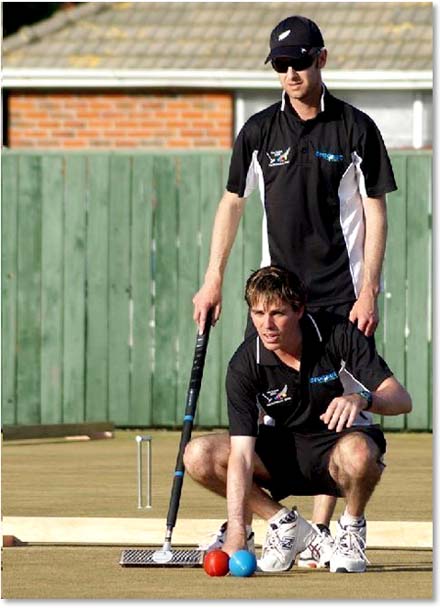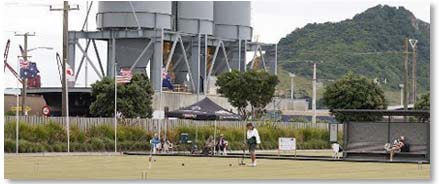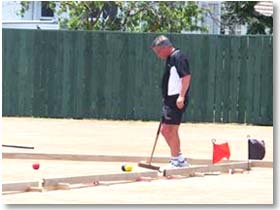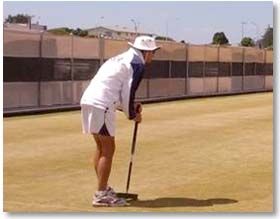y croquet travels are notorious! I started club croquet at Cheltenham, England, in 1978. No sooner had I established my credentials and begun to play in the top tournaments than, in 1982, I emigrated to New Zealand. It was here that I improved my game to International standard and represented my adopted country from 1988 to 2000. At the supposed peak of my powers, I moved to Australia. where I represented that country both as a player and as a coach/manager. Then what? I returned to New Zealand in late 2010! Though I have not lived in USA, I have played a number of top-level tournaments there by both American Rules and Association Croquet laws.
What are the differences in the croquet played in these four countries? At the time I returned to New Zealand, the country had just regained its traditional spot of 2nd in the MacRobertson Shield after two outings (2003 and 2006) when they came 4th. On the other hand, Australia had slumped from 2nd to 4th but had just won its first Trans Tasman Test (against the Kiwis) since 1991.
There is more to croquet than International results, however. Unlike my first and second croquet moves, my latest one was not work-related. I had retired from my job in Australia in 2010 and so became a “free agent". We had children and an increasing number of grandchildren in New Zealand, so there was plenty of motivation for returning "home"--and yes, New Zealand has always felt like home to me despite my triple nationality.
Coaching the Australian team
for the Australian Croquet Association
By the end of 2010, I had just completed three years as Australian Team Coach. This was a position I had applied for, and been appointed by the Australian Croquet Association. I personally felt no surprise that Australia lost a Tasman test and three Mac tests during my tenure, as so many off-field distractions and ugly behavior undermined our progress.
But I also observed some interesting issues. For example, there were a high number of un-coachable players in the upper echelon in Australia. Some were un-coachable because they mistakenly thought they knew best and resisted change, despite Australia's generally poor showing in international events since 1935, crying out for a different approach. Others were un-coachable because they did know best but did not want to avail themselves of the considerable experience of others, including existing team members.
Having said this, do not get the impression that all Australian players are like this—that is far from the truth, and I received much support from many players from all States, and thoroughly enjoyed coaching them and playing with and against them. However, I eventually gained the strong feeling that Australian teams thrive on the conflict generated within, and perform more poorly without it. (I suspect British teams may be the same.)
I was successful in removing the conflict, but the team didn't play any better, and that was a surprise to me. This discovery was a major reason why I turned down the invitation from the ACA to remain as Australian Team Coach after the 2010 Mac.
New Zealand traditionally does not have a team coach. They rely on a team support network where everyone helps everyone else, including the wider team network of former international players. They take more of a High Performance Management approach, with a person or sub-team doing the organizing. The other two countries (England the US) seem confused on this issue as sometimes they have a coach, and sometimes they don't.

|
| This photo of Toby Garrison with partner Aaron Westerby, backed by a fence protecting a residential neighborhood from seeing too much croquet, reveals both the essential character of the second venue--Napier--as well as the unique style of "self-management" which seemed to work so well for the New Zealand team. Paddy Chapman photo.
|
The differences between Australia and New Zealand
There are a number of differences between New Zealand and Australia in playing characteristics. Terminology is different, e.g. "border" v "line" though players from both countries call you "mate"! Play is always aggressive, though Australians tend to shoot at everything come-what-may, which can sometimes be their undoing. (British and American players tend to do the same but seem to hit more often!)
Because New Zealand has been blessed in recent years with some of the world's best-ever players (for example Ashley Heenan, John Prince, Bob Jackson, Joe Hogan, Paul Skinley), its merely mortal players have been brought up with great skills and tactical nuances. This is apparent, for example, when watching the "apres-tpo" tactics employed by players from different countries. Indeed, I once partnered a very senior Australian player in the Interstate Cup who admitted, in the middle of a pegged-out game, that he didn't know anything about tpo's!
Where the Kiwis and Brits excel
There is also a difference between players when they are playing under pressure, with the Kiwis and the Brits being more capable in this skill. Part of the reason for this may lie in the greater quantity of top level games available in England and New Zealand, with Australia and USA suffering in this regard due to what they term the "tyranny of distance".
This brings me to the fundamental difference between Australian and New Zealand croquet. On the one hand, some Australian players do not operate well in teams. They tend to look out for themselves with little concern or support for anyone else, including their team mates, and thrive on conflict. The New Zealand ethos is the opposite, as players have a quietly relaxed yet committed approach and support each other to the hilt. This does not mean that New Zealand never has problem players, but that issue is dealt with appropriately by the Kiwis.

|
| Mount Maunganui Croquet Club, the third and decider venue for the 2014 MacRobertrson Shield, hosted all the games in the third, final, and deciding test, which New Zealand won handily against England. The looming presence of the mountain and the power lines added moment to the occasion. Paddy Chapman photo.
|
In England, croquet is a very much more social game. Everything seems to revolve around lunch (and morning and afternoon tea), even at major tournaments. It is considered very strange if one does not put down one's mallet at the ring of the bell and partake in toad-in-the-hole followed by a decent portion of English trifle. And then there's the bar afterwards--after every game, that is! Americans often express surprise when they hear of the British custom of having the winner buy the loser a drink at the bar.
In the USA, there can be confusion in the two codes to overcome. (That's American Rules, not Golf Croquet.) US players occasionally become confused in Association Croquet events, setting up with blue for black to play a rush on yellow, for example. Non-US players are equally confused by the US players' confusion!
By the same token, players of both codes occasionally play the rover hoop from the wrong direction, forgetting that in American Rules only, the rover hoop is played towards the peg.
I have observed that US players can suffer from an inferiority complex in world croquet events, though there is no need to, as the quality of their play is very high. Their demeanor, typically, is one of quiet but intense determination behind a facade of loud gusto.
Southern hemisphere advantages
There are several areas that both the southern hemisphere teams have developed successfully: for example, young player development. Associations in New Zealand began schools programs in the 1990's which still continue today and you only have to look at the Fletchers to understand how young players have developed in Australia.
England were successful in this regard in the 1980's, when a number of top players emerged from schools. Squad systems have also been popular in most countries, and young (croquet-wise) players have often talked to me about how good their squads sessions were and how proud they felt to be in a National Squad.
National Squads are set up to include the best players in the country, meeting regularly (usually over a weekend) to bond as a team, practice, discuss strategy, receive sports psychology, and play games, usually in preparation for a specific event, such as the MacRobertson Shield. All the "big four" have some version of the "selection eights" played as single-game round-robins in tiers determined by estimated rankings. Those results figure into the selection of the six-member national teams.
One area that does not seem to have been universally embraced, however, is Sports Psychology. Many players are strongly in favor of this, understanding that the "inner game" is vitally important in elite croquet. Others don't seem to want any part of it. I can never understand why most if not all top players in virtually every sport (both individual and team) will spend time on Sports Psych, with the sole exception (it seems) of croquet players. Those who do appreciate this topic are likely to develop a better understanding both of themselves and the mental side of the game. Outstanding examples of players who do appreciate the merits of personal Sports Psychology are Reg Bamford and Mark McInerney.
The role of Flair
Finally, I must make mention of my favorite subject: Flair. Flair is a concept which is rather nebulous but vitally important in top class croquet. It is the difference between success and failure, a good player and a great one, competing and winning. It is that unquantifiable quality that produces a winner, a shot that turns the course of a game, in a turn that changes the course of a match.

|
| The formidable Atkins Quadway hoop, developed by Ray Atkins of Christchurch and engineered to be adjusted in width while in the ground and hold a precise setting, was used for the first time on all the courts used in the 2014 MacRob, whether on hard ground or in sand. It was a comprehensive test of the kind of hoop which, by being so remarkably unforgiving, guarantees more interactive games and matches at top level. Paddy Chapman photo.
|
There are few players who can display Flair consistently while playing croquet at the highest level. Of the modern examples, Fulford, Maugham, Prince, Skinley, Hogan, Spooner and Stark come to mind. In their day, they could turn a match in their favor merely by playing a single Flair shot. Examples would be hitting a sliver of a ball hidden behind a hoop from 12 yards (as Skinley did in a MacRobertson test match in 1986), or just one particular and apparently low-percentage shot to get a break from a contact leave.
Or the Flair could be a passage of play such as Maugham's famous 2-ball break to win Great Britain's 11th match of the Mac versus New Zealand in 1993. In general, British players have had the virtual corner on Flair since 1990 mainly due to the stability of their top three players. New Zealand's Flair has not been far behind as it is a way of life for their nation, being a young country.
Australia and USA have a long way to go in the Flair stakes. For other players, while they may not show Flair on a consistent basis, they more than compensate by exhibiting supreme skills and dogged determination. Jackson, Clarke, Openshaw, Fletcher and Rothman are examples of players of this type. Indeed, these attributes themselves could be considered Flair. Players of the current era have just provided us with many examples of Flair at the MacRobertson Shield series in New Zealand. For example:
· New Zealand v Australia 6 Jan 2014 Napier:
Doubles Game 2

|
| Chris Clarke (NZ) prepares for his potentially deadly 30-yard “Flair shot”, gaining a rush to rover on a line ball. Photo by Steve Jones.
|
Chris Clarke had played himself into a corner with his partner ball, corner 2 to be precise. A lift was pending and already the two lift positions near hoops 2 and 4 were occupied by opposition balls. Chris was for rover but had nowhere to go. The only "live" ball was the opponent ball on the East boundary near hoop 4. Leaving his partner ball close to an opponent ball, Chris boldly took off to it from corner 2 to the live ball. This was a 30-yard croquet shot to an almost impossible position one yard from the boundary, which, had his ball gone out of court, would have meant instant “deadness” and the certainty of the opposition gaining the innings. But Chris managed, incredibly, to get the rush to rover he needed to score the hoop and win the game and the match.
· England v New Zealand 14 Jan 2014 Mt. Maunganui:
Doubles Game 2

|
| England’s Stephen Mulliner displaying his trademark “press-up” to eye up a tricky hoop. Photo by Paddy Chapman.
|
This was Stephen Mulliner's 7th MacRobertson Series and rarely has he achieved such an impressive break as this one. It was on a difficult lawn on a hot, windy afternoon, and Stephen was under pressure to elevate England's flagging fortunes. He began on hoop 5 with the opponents' balls in corners 1 and 3. With infinite patience he completed what he called an "old-fashioned" break to the peg, gradually moving the opponents' balls further and further into the court. Stephen said afterwards "I was quite pleased with that"!
· USA v Australia 14 Jan 2014 Mt. Maunganui:
Singles Game 3

|
| Jeff Soo hit the low-percentage, 22 yard “John Hardy” shot, and progressed to 4-back with a fine break.
|
In the same hot windy conditions at the start of the third game of another tense match, Jeff Soo pulled off what I call the "John Hardy" shot. In Queensland, Australia, a player called John Hardy is very keen on making a double of the opponent balls on the West boundary near hoop 4 from B-baulk and shooting at it with the 4th ball. He got members of the Queensland State team to practice this shot all the time, but they rarely hit it! Jeff nailed the shot nonchalantly, and progressed to 4-back.
· Australia

|
| Sadly, I do not have in my camera examples of Flair from Australia, but I do have this photograph of green footwear worn by an Australian player through the series. Flair, surely! Photo by Steve Jones.
|








